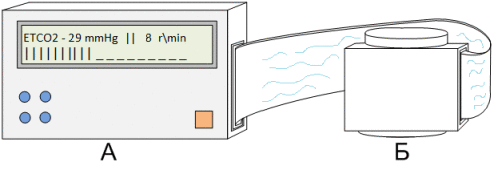Abstract
Contents
Introduction
The device is designed to control the parameters of the exhaled carbon dioxide, reflecting its concentration and breathing rate to display information display, helping rescuers and workers to keep track of the current status of the person.
1. Relevance
In our region with its well-developed system of the coal industry, personal protective equipment, including self-contained breathing devices, become more and more relevant. During accidents at coal mining enterprises, it often happens that the air, breathed by the miners and rescuers, is very dirty with methane, coal dust etc. In such cases it is necessary to use personal protective equipment. Developed device must control the parameters issued by carbon dioxide and show their concentration and breathing rate on information display, helping rescuers and workers to keep track of the current status of the person.
2. Purpose and objectives
The purpose of development is reducing the time of preparation for the use and display of the information received measurement and integration of new technical elements. The instrument is designed to measure the concentration of carbon dioxide mine-rescue equipment.
The device shall consist of the following components:
– Measurement channel optical tests designed to measure the concentration of carbon dioxide
– Analog Multiplexer designed for serial connection of measuring channels to the input of the digital portion of the device;
– Analog-to-digital converter;
– Microprocessor unit designed to determine the concentration of the medium and output the result on the display.
3. Analysis Tasks
1. To analyze the existing methods and means for measuring the concentration of carbon monoxide, to select the method with high accuracy and selectivity.
2. Development of a mathematical model of breathing device
3. To develop a mathematical model of the measurement system.
4. To investigate the function of the mathematical model of the measurement system with the inclusion of the respiratory system model.
5. To investigate the concept of the unit of carbon dioxide control in structure of mine-rescue equipment test.
4. Analysis
To implement the method in the block diagram the source of narrow band radiation with a spectrum of radiation coincident with the carbon dioxide absorption spectrum, the optical circuit, which provides irradiation of the gas-air mixture, a photodetector, which provides optical radiation flux conversion to signal convenient for further processing with release of information about the concentration of carbon dioxide, are provided. To reduce the noise level of the detector and the signal processing device modulation of the optical flow is provided. To implement a modulation scheme structural calculation of output signal of voltage concentration transducer, implemented in Matchcad, are provided.
5. Appearance
According to the technical data of reference and considered analogues of our device settings must be made in the form of a block with dimensions of 50 X 100 X 50 mm. Housing made of polyamide plastics. Weight should be minimal and not exceed 100, the structural embodiment of the device shown pic. 5.1.

Figure 5.1 – design of the device A) of the computing B) remote module.
1 – LCD-display; 2 – Working cell input sample; 3 – Working cell output utilization samples, 4 – trim elements, 5 – Power on/off button, 6 – Battery installation location, 7 – Input/Output to Bus

Figure 5.2 – Visual representation of the designed device control carbon dioxide design of the appliance A) computing part B) remote unit with the PDP. United through the bus.
(Animation: 10 frames, 5 cycles of repetition, 123 kilobytes)
(Animation: 10 frames, 5 cycles of repetition, 123 kilobytes)
